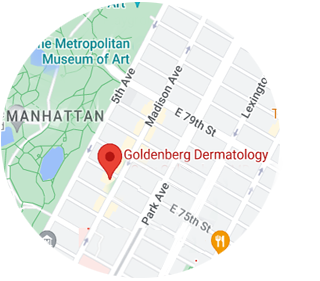What Causes Female Hair Loss & How to Treat It
The Top Causes of Female Hair Loss & How to Treat Them –
Hair loss in women is a complicated matter. And, as with any medical condition, diagnosing the underlying cause of the hair loss is the first step to finding the best treatment for it.
Most people think of hair loss or “baldness” as a men’s issue – because it is more widely talked about. But more than 50% of women will also experience noticeable hair loss at some point in their life. Unfortunately, most women are too embarrassed to discuss their situation, or to seek help.
But if a woman finds that the part in her hair is widening, she is developing bald spots, or she is shedding more than 125 hairs per day, she is experiencing hair loss and should see a dermatologist right away. At Goldenberg Dermatology in NYC we offer several treatments to stop hair loss and restore hair growth in women – and the sooner they are started, the better the results!
Causes of Female Hair Loss
#1. Hereditary Female Hair Loss
“Androgenetic Alopecia” – also called Female Pattern Hair Loss (FPHL) – causes hair follicles to “shrink”. This results in hair falling out faster, and growing back more finely, in a process called “miniaturization.” The result is “wispy hair” with fewer follicles per inch of scalp.
This is the most common cause of female hair loss and is thought to be caused by a combination of genetic (hereditary) factors and hormonal influences.
#2. Hormonal Female Hair Loss
Androgens (male sex hormones) have many important functions in both males and females, in addition to regulating sexual drive and performance. These hormones also regulate hair growth and sex drive. Increased levels of androgens can lead to a shorter cycle of hair growth and the growth, production of shorter and thinner hair strands, and cause a delay in the growth of new hair to replace strands that are shed.
Hormonal hair loss is most common during menopause when estrogen and progesterone levels decline, resulting in the effects of the androgens increasing.
Another type of hormonal hair loss is “telogen effluvium” (TE) – the second most common type of female hair loss. TE results in thinning of the number of hairs on the scalp, especially at the top of the scalp.
While Telogen Effluvium hair loss can be triggered by a wide variety of different factors, the hormonal changes of pregnancy can result in TE hair loss for 6 months to a year after delivery.
#3. Female Hair Loss Due to Stress
Extreme physical stress or shock to the body can also cause female hair loss. This may include events such as suddenly losing a lot of weight, surgery, anemia, or an illness
Dermatologists know that mental stress can also lead to female hair loss. Mental stress can lead to Alopecia Areata hair loss, in which the body’s own immune system actually attacks the hair follicles.
#4. Female Hair Loss Caused by Environmental Factors
Medications including antidepressants, anti-hypertensive drugs and oral contraceptives, may also cause female hair loss. In other women, a vitamin or nutritional deficiency may be the root cause of thinning hair or balding patches.
Another type of hair loss called Traction Alopecia is also more common in women, because it is caused when the hair is styled in ways that pull on the roots. This can include tight ponytails, braids, corn rows, extensions or weaves. This tension on the hair roots can damage or destroy hair follicles, in some cases leading to permanent hair loss.
Treatments for Female Hair Loss
The different types of hair loss are complex and diverse, and the best treatment for you will depend upon which type of female hair loss you have. So, the first step is always a consultation with a dermatologist who specializes in hair loss, like renowned hair-restoration pioneer Dr. Gary Goldenberg in NYC. He will identify the type and cause of your hair loss – so that the most effective treatment(s) can be prescribed.
The dermatologists at Goldenberg Dermatology in NYC offer many different and highly effective treatments to combat female hair loss. These state-of-the-art hair loss treatments include: PRP treatment and stem cell therapy hair restoration – as well as oral medications, topical medicines, and nutritional support for hair re-growth.
#1. PRP for Female Hair Loss
“Platelet Rich Plasma” (PRP) and Stem Cell Therapy all harness the body’s own healing mechanisms to repair hair follicles and restore hair growth – naturally and without surgery. These hair loss therapies can effectively treat Female Pattern Hair Loss (FPHL), Traction Alopecia, Telogen Effluvium, and several other types of hair loss in women, as well as men!
PRP hair loss therapy involves extracting certain specific proteins called “growth factors” that stimulate the body’s healing ability from the patient’s own blood – and then injecting it into the scalp to repair the damaged follicles.
#2. Stem Cell Therapy for Female Hair Loss
During stem cell hair loss treatment Dr. Goldenberg harvests stem cells from the patient’s own body fat, and then re-injects them into the scalp. The stem cells go to work re-growing blood vessels, calming the inflammation, and stimulating the hair follicles to once again begin producing strong, healthy hair shafts.
Female Hair Loss Treatment NYC
Each individual woman’s type, cause, location and degree of hair loss is different. So one treatment will work better for some patients, while a different hair restoration therapy may work better for another woman. Or a combination of both may be most effective!
Scheduling a consultation with board certified dermatologist and hair restoration expert Dr. Goldenberg in NYC is the first step to understanding the cause of your hair loss – so that the best treatment plan can be put in place. Dr. Goldenberg is one of only a few medical practices anywhere in NYC, the State of New York, New Jersey or on the entire East Coast offering all of these innovative and highly effective new hair loss treatments.
Call Goldenberg Dermatology in NYC today, and schedule a confidential appointment with Dr. Goldenberg to see which hair loss treatment is best right for you.











